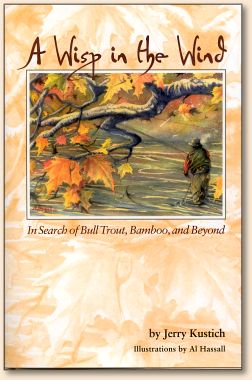Reviewed by Paul F. Vang, MT
 It's ironic how it turned out. My friend, Jerry Kustich
of Twin Bridges, Montana, is a flyfisherman, rod builder
and writer. His latest book is, A Wisp in the Wind;
In Search of Bull Trout, Bamboo and Beyond. Previous
books are At the River's Edge, and Flyfishing
for Great Lakes Steelhead, co-authored with his
brother, Rick Kustich.
It's ironic how it turned out. My friend, Jerry Kustich
of Twin Bridges, Montana, is a flyfisherman, rod builder
and writer. His latest book is, A Wisp in the Wind;
In Search of Bull Trout, Bamboo and Beyond. Previous
books are At the River's Edge, and Flyfishing
for Great Lakes Steelhead, co-authored with his
brother, Rick Kustich.
The theme of the book is an in-depth and loving view of the
R. L. Winston Rod Company's bamboo flyrod shop. Kustich learned
the craft of bamboo rodmaking under Glenn Brackett, a former
co-owner of Winston Rods, and part of the team that moved
Winston from San Francisco to Twin Bridges in 1976.
Some anglers believe there's a mystique to bamboo rods. Years
ago, most fishing rods, especially flyrods, were made of bamboo.
In the post-WWII years, fiberglass and then graphite-based
materials replaced bamboo for the bulk of the angling public.
Bamboo remains the material of choice for a relatively small
handful of craftsmen around the country who continue to turn
out split bamboo rods for discerning anglers, many of whom
refuse to fish with anything but bamboo.
The Winston Rod Company is the one of the few mass-production
companies that still produce bamboo flyrods. They are clearly
a premium rod; a three-piece trout rod retails for $3,000.
A Wisp in the Wind centers on the bamboo shop
that's located in a non-descript metal building in a back
alley in Twin Bridges, blocks and years removed from the
modern Winston headquarters building on the outskirts of
town. In the book, Jerry describes the rod-building process
and the many painstaking steps involved with building a
bamboo rod.
The author uses conversations among the rod builders in the
Winston shop as a basis for examining what's good and what's
disturbing about the environment, pressure on fishing waters,
life in small towns in rural Montana, family relationships,
and, of course, fishing, particularly fishing with bamboo rods.
As Jerry says in one chapter, "There is something special about
the rods we build. It is undeniable. You can sense the magic
in the completed work."
Let me cut to the chase. "Wisp in the Wind" is a total delight.
I'm a relatively fast reader but I deliberately rationed the
amount of time I spent on reading 'Wisp', because I wanted to
prolong the pleasure.
Now for the irony. At the time the book came out in December,
the four bamboo rod builders resigned their jobs. The basis
for the resignation revolved around Brackett's hiring an apprentice
for the bamboo shop. The prospective employee from out-of-state
had quit his job, put his house on the market, and was preparing
to move to Twin Bridges just to learn, at a low wage, the craft
of bamboo rod building at the side of the masters. When Winston's
CEO, Mike "Woody" Woodard nixed the deal, Brackett resigned in
protest. Jerry Kustich, Jeff Walker and Wayne Maca followed suit.
These four craftsmen had a combined 80 years of rod building
experience.
In January I spent an afternoon with Kustich at the bamboo shop.
Jerry showed me the operation, starting with bamboo, the machinery
that cuts bamboo into strips, and the painstaking process of gluing,
sanding and varnishing that turns raw materials into precious
heirlooms.
The rod builders were working hard to finish a number of rods
they had committed to complete before the end of January (later
extended to mid-February). Still, there was a palpable sadness
in the air. There was also a sense of bitterness about what
happened. Perhaps there was also a sense of relief as well.
Tensions between CEO Woodard and the bamboo shop group have
been building a long time, due in part to Woodard's frequent
sniping at the independent, though highly profitable, way this
little 'skunkworks' operated.
Woodard maintains that R. L. Winston will continue to make
bamboo rods with employees reassigned from the main facility.
In the March 2006 issue of Flyfisherman magazine, Woodard
said, "Our goal is to continue to build the best bamboo rods
in the world right here in Twin Bridges."
Perhaps. Nevertheless, if I ever feel rich enough to splurge
on one of those $3,000 bamboo rods anytime in the near future,
I'd first make sure it was built in Glenn Brackett's shop in
the good old days. Then I'd re-read A Wisp in the Wind
for Jerry Kustich's affectionate account of its making. ~ PFV
A Wisp in the Wind
By Jerry Kustich
Hardcover, 16 beautiful illus; 6x9 inches, 240 pages
West River Publishing Co, November 2005
ISBN: 0-9633109-4-1
Price: $24.95 US
Previous Reviews
|



